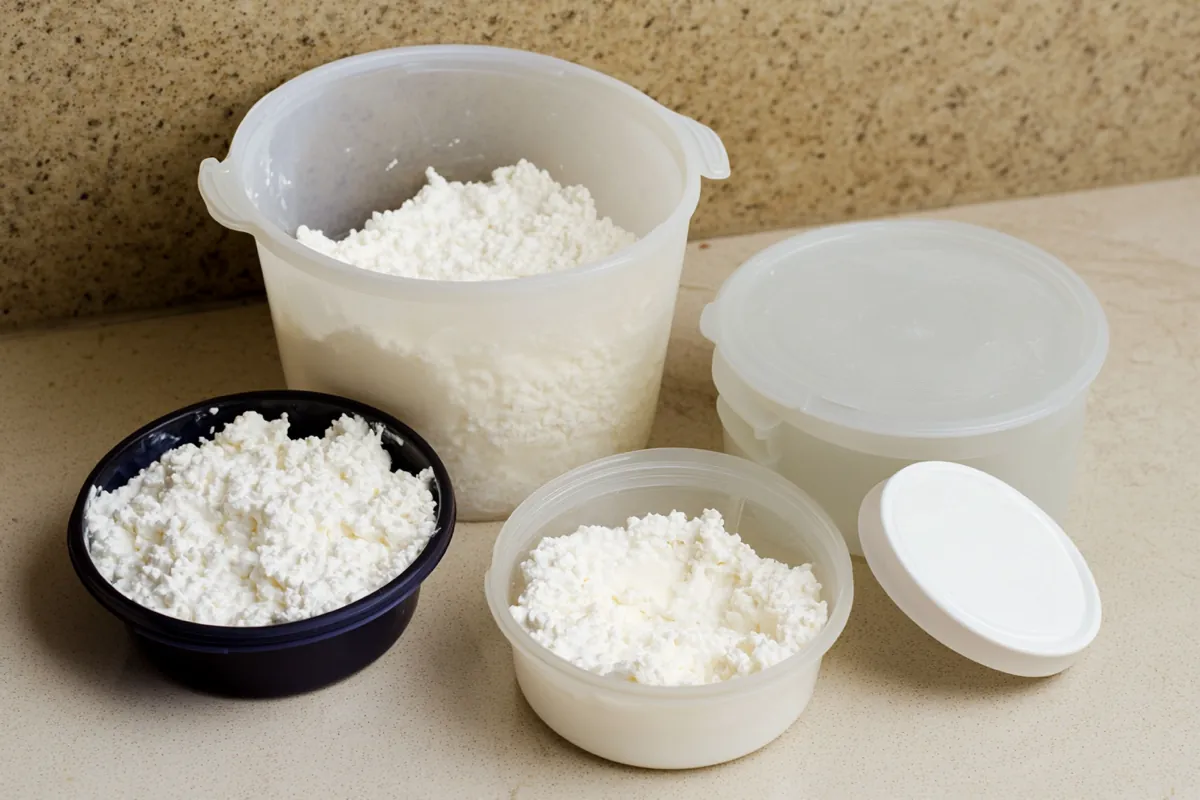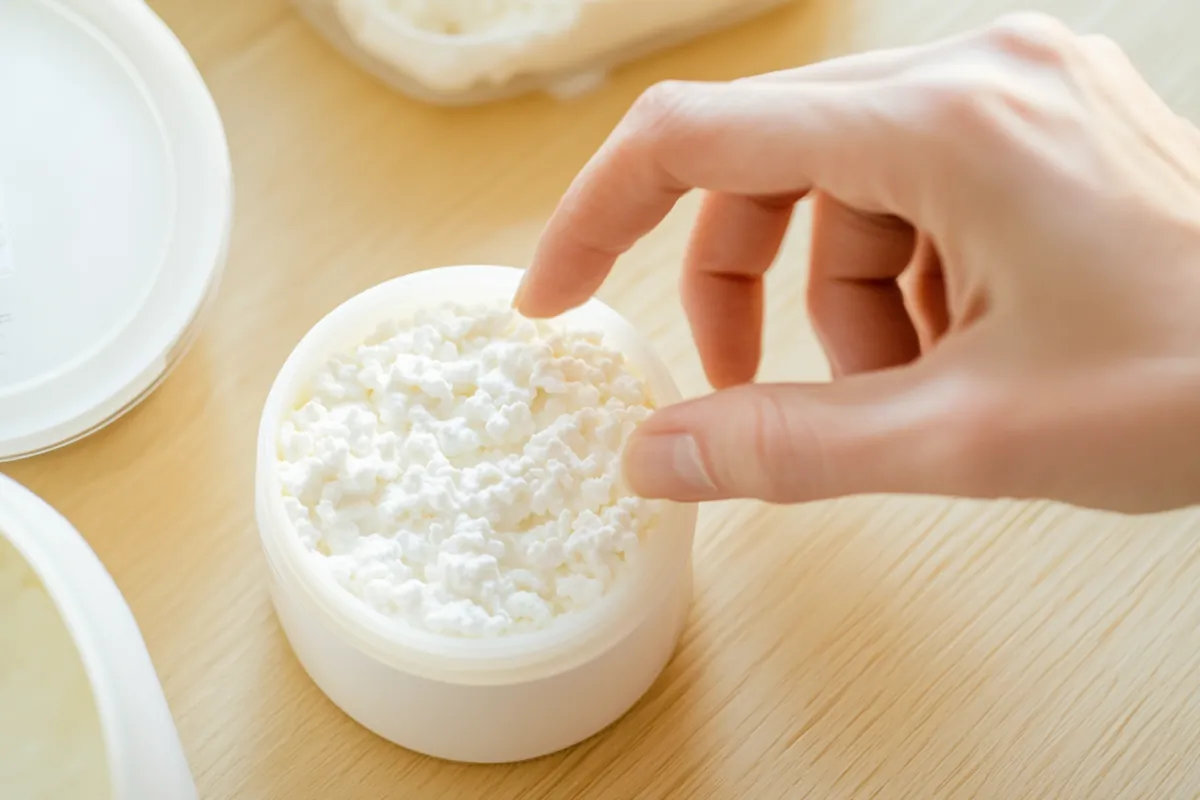Cottage cheese is a delicious and nutritious option for many meals. However, keeping it fresh can be a challenge. In this comprehensive guide, we will explore cottage cheese storage and freshness, focusing on how to maintain its quality whether stored in the fridge or freezer.
Table of Contents
Understanding Cottage Cheese
Cottage cheese is known for its unique texture and mild flavor. It’s a versatile ingredient used in various dishes from salads to desserts.
What is Cottage Cheese?
Cottage cheese is a fresh cheese made from curds, which are formed by adding an acid to milk. After the curds form, they are drained and rinsed, resulting in a creamy yet lumpy texture. This dairy product is often low in fat and high in protein, making it a popular choice among health-conscious individuals.
Nutritional Benefits of Cottage Cheese
Cottage cheese is packed with essential nutrients. It contains:
- High Protein: Provides a great source of protein for muscle repair and growth.
- Calcium: Important for bone health.
- Low Calories: A filling option without excessive calories.
These attributes make cottage cheese an excellent addition to a balanced diet. For more ideas on cottage cheese recipes, check out our guide on healthy cottage cheese and eggs.
Importance of Proper Storage for Freshness
Storing cottage cheese properly is crucial to maintaining its freshness. Improper storage can lead to spoilage, affecting both taste and safety.
How Storage Affects Quality and Taste
The way you store cottage cheese can significantly impact its quality. Exposure to air can cause it to dry out, while improper temperatures can lead to bacterial growth. Therefore, it’s essential to keep it in appropriate conditions to ensure it remains creamy and flavorful.
Shelf Life of Cottage Cheese: An Overview
The shelf life of cottage cheese varies depending on how it is stored. Generally, it can last about:
- Unopened: 1-2 weeks past the expiration date when refrigerated.
- Opened: 5-7 days in the fridge.
For those looking to extend the life of their cottage cheese, proper storage techniques in the fridge or freezer can be incredibly beneficial.
Cottage Cheese Storage and Freshness in Fridge
Storing cottage cheese in the fridge is the most common method. However, there are specific guidelines to ensure maximum freshness.
Optimal Refrigerator Temperature
Keeping cottage cheese at the right temperature is vital. The ideal refrigerator temperature is between 34°F and 40°F (1°C to 4°C). Ensure your fridge is set correctly to maintain this range.
Ideal Conditions for Storing Cottage Cheese
- Airtight Container: Transfer cottage cheese to an airtight container if it isn’t already. This prevents air exposure.
- Keep Away from Odorous Foods: Store it away from strong-smelling foods, as it can absorb those odors.
Best Practices for Fridge Storage
- Seal Tightly: Always close the container tightly after use.
- Don’t Double Dip: Avoid using utensils that have been in other foods to prevent contamination.
By following these practices, you can maximize the shelf life and quality of your cottage cheese in the fridge.

Signs of Freshness: How to Identify Fresh Cottage Cheese
Identifying whether cottage cheese is fresh is essential for both taste and safety. Here are key indicators to help you determine its freshness.
Checking Expiration Dates
Always start by checking the expiration date on the packaging. Even if the date has not passed, you should look for other signs of freshness. When you check the date, remember that cottage cheese may still be safe to eat for a short period after, but it’s best to use your senses to confirm its quality.
Visual and Sensory Indicators of Freshness
When evaluating cottage cheese, consider the following:
- Appearance: Fresh cottage cheese should look creamy and white. If you see excessive liquid or a change in color, it may be spoiled.
- Texture: It should have a smooth, creamy texture without any lumps or dryness.
- Smell: Fresh cottage cheese has a mild, slightly tangy smell. If it has a sour or off odor, it’s likely gone bad.
Trust your senses! If anything seems off, it’s better to discard it. You can also check our ultimate guide to cottage cheese recipes for ideas on how to use cottage cheese creatively.
Cottage Cheese Storage and Freshness in Freezer
Freezing cottage cheese is a great way to extend its shelf life. However, proper methods must be followed to maintain its quality.
Benefits of Freezing Cottage Cheese
Freezing allows you to keep cottage cheese for several months. This can be particularly useful if you buy in bulk or want to preserve leftovers. Moreover, it helps to minimize food waste, ensuring you get the most from your purchase.
How to Freeze Cottage Cheese Properly
To freeze cottage cheese effectively, follow these steps:
- Choose the Right Container: Use a freezer-safe, airtight container to prevent freezer burn.
- Portion It Out: If you plan to use only part of the cheese later, consider freezing it in smaller portions.
- Label the Container: Write the date on the container to track how long it has been frozen.
Ideal Freezing Conditions
Cottage cheese should be frozen at 0°F (-18°C) or lower. Ensure your freezer maintains this temperature for optimal preservation.
Thawing Cottage Cheese: Best Practices
When it comes time to use frozen cottage cheese, proper thawing is crucial:
- Refrigerator Thawing: The best method is to place it in the fridge overnight. This allows it to thaw slowly, preserving texture.
- Quick Thawing: If you need it sooner, you can use the microwave. However, use a low power setting to prevent cooking it.
After thawing, be aware that cottage cheese may have a slightly different texture. It might be less creamy than before, but it remains safe and delicious for various recipes. For more tips on enjoying cottage cheese, check out our insights on cottage cheese baking substitutions.
By implementing these storage strategies, you can ensure that your cottage cheese remains fresh and ready for use in your favorite dishes, whether you’re keeping it in the fridge or freezer.

Common Mistakes in Cottage Cheese Storage and Freshness
Even with the best intentions, it’s easy to make mistakes when storing cottage cheese. Understanding these common errors can help you maintain its freshness longer.
Should You Store Cottage Cheese Upside Down?
One common myth is that storing cottage cheese upside down can help keep it fresh. However, this practice can lead to contamination. The lid may not create a perfect seal, allowing air to enter and spoil the cheese. Instead, always store cottage cheese upright in an airtight container to maintain its quality.
Avoiding Contamination: Dos and Don’ts
To prevent spoilage and ensure your cottage cheese stays fresh, keep these dos and don’ts in mind:
Dos
- Do Use Clean Utensils: Always use a clean spoon or knife to scoop out cottage cheese. This prevents introducing bacteria from other foods.
- Do Check for Spoilage Regularly: Regularly inspect your cottage cheese for any signs of spoilage, such as off smells or unusual textures.
Don’ts
- Don’t Leave It Out: Avoid leaving cottage cheese at room temperature for extended periods. Bacteria can grow rapidly in the danger zone between 40°F and 140°F (4°C to 60°C).
- Don’t Mix Old and New: When using cottage cheese, don’t mix older cheese with fresh. This can cause the entire batch to spoil faster.
By avoiding these mistakes, you can significantly extend the freshness and quality of your cottage cheese. For more insights into maximizing the use of cottage cheese in your cooking, visit our ultimate guide to cottage cheese flatbread.
Extending the Shelf Life of Cottage Cheese
To get the most out of your cottage cheese, consider taking steps to extend its shelf life.
How to Keep Cottage Cheese Fresh Longer
There are simple methods to prolong the freshness of your cottage cheese. Here are a few effective strategies:
Using Airtight Containers
Invest in high-quality airtight containers. These containers help prevent air exposure, which can lead to spoilage. Make sure they are well-sealed after each use.
Incorporating Natural Preservatives
Another great way to keep cottage cheese fresh is by incorporating natural preservatives. For example, adding a small amount of lemon juice can help enhance its shelf life while adding a hint of flavor. Always remember to mix gently to avoid changing the texture significantly.
By implementing these strategies, you can enjoy your cottage cheese for a longer time, ensuring you always have this nutritious option on hand for your meals.

Conclusion
In summary, understanding cottage cheese storage and freshness is essential for enjoying this nutritious food at its best. By following proper storage techniques, recognizing signs of freshness, and avoiding common mistakes, you can ensure that your cottage cheese remains delicious and safe to eat.
Recap of Key Storage Tips
- Store cottage cheese in an airtight container.
- Keep it refrigerated at the optimal temperature.
- Check regularly for signs of spoilage.
- Use it within 5-7 days after opening.
Final Thoughts on Cottage Cheese Storage and Freshness
Whether you prefer it in savory dishes or sweet desserts, maintaining the freshness of cottage cheese allows you to enjoy its benefits fully. With these tips, you can confidently store and use cottage cheese in a variety of recipes.
FAQ
When it comes to cottage cheese storage and freshness, many questions arise. Here are some common inquiries and their answers.
How to Keep Cottage Cheese Fresh Longer?
To keep cottage cheese fresh for an extended period, store it in an airtight container in the fridge. Be sure to seal it tightly after each use. Additionally, you can freeze cottage cheese for longer storage. When thawing, do so in the refrigerator to maintain quality.
How Do You Know If Cottage Cheese Has Gone Bad?
You can tell if cottage cheese has spoiled by checking for specific signs. Look for:
– Off Smell: A sour or unpleasant odor indicates spoilage.
– Texture Changes: If it appears dry, lumpy, or has separated liquid, it’s best to discard it.
– Color: Any discoloration or changes in color should raise a red flag.
How Long Can You Keep Cottage Cheese Once Opened?
Once opened, cottage cheese should be consumed within 5-7 days for optimal freshness. Always check for signs of spoilage before using it. If it has been stored properly, it may still be safe to eat for a few days beyond this timeframe.
Should You Store Cottage Cheese Upside Down?
No, storing cottage cheese upside down is not recommended. This method can lead to contamination and spoilage due to improper sealing. Always store cottage cheese upright in a well-sealed container.




